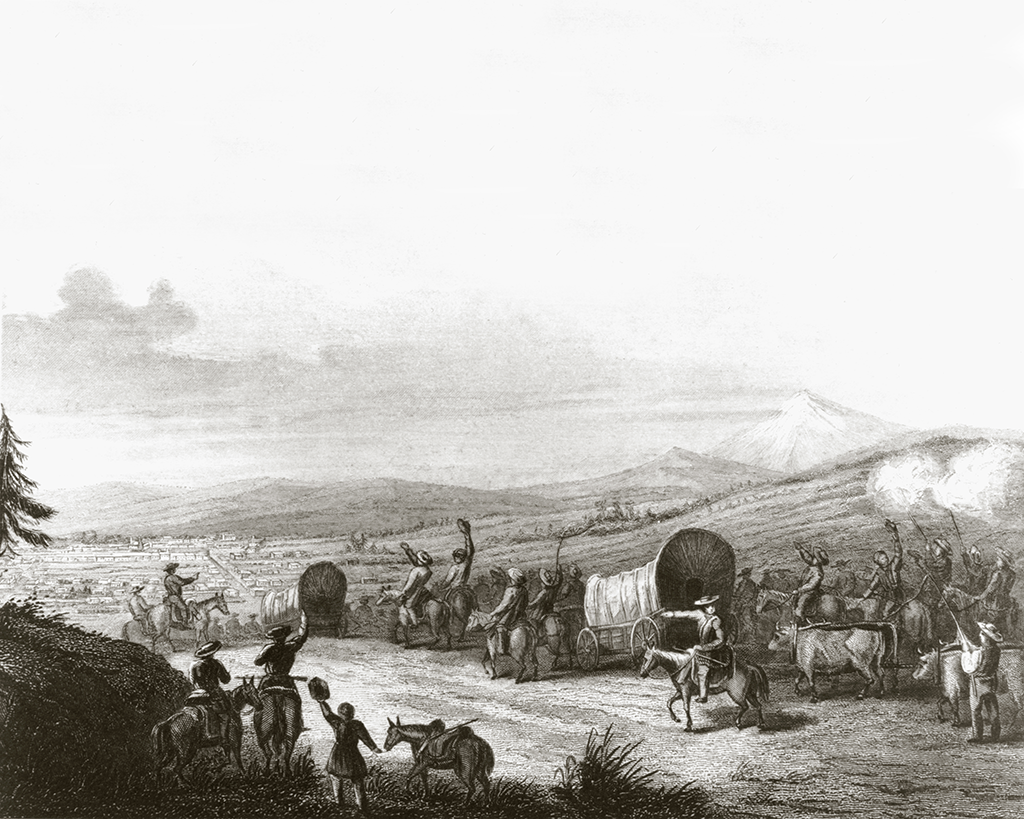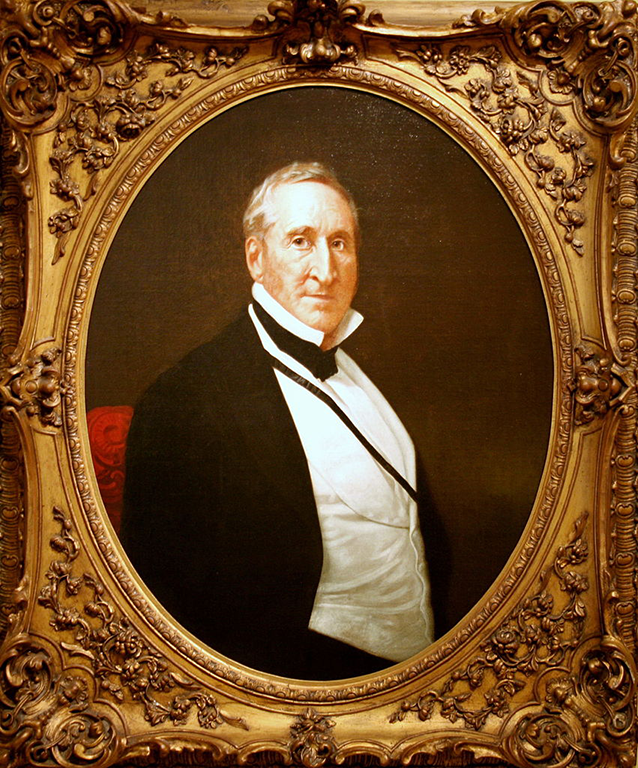The History of New Mexico
Collapse
Expand
-
Chapter 7: The Mexican Period, 1821-1848
- The Mexican Period, 1821-1848
- Mexican Independence & New Mexico
- Opening the Santa Fe Trade
- "War of a Thousand Deserts"
- Colonization, Political Conflict & Rebellion
- References & Further Reading
The 1821 opening of the Santa Fe Trade was the aspect of Mexican independence that most directly and most immediately impacted New Mexico. Mexican leaders hoped that loosening Spanish colonial trade restrictions would strengthen the new nation’s weak economic situation—especially in its northern provinces. For decades American merchants in Missouri coveted the profits to be had in New Mexico, but they had been unable to establish trade ties. One of the first actions of the Mexican government was to end the prohibition, and American traders soon made their way to Santa Fe.
Missouri merchant [glossary_exclude]William Becknell[/glossary_exclude] is credited with initiating the trade from Independence, Missouri. As early as 1819, however, other hopeful Americans entered Santa Fe along the same route in hopes of opening new markets. All comers followed a trail that had been blazed in 1792 by French explorer Pierre Vial (often called Pedro in Spanish records). Like Jean L’Archevêque, Vial was a Frenchman who spent much of his life in New Mexico. By the 1790s, he was the province’s informal explorer.
William Becknell was a young, thirty-one-year-old salt maker from Franklin, Missouri, whose livelihood had been crippled by the economic panic of 1821. On the verge of imprisonment for debts he had incurred, Becknell took the risk of leading a trade caravan along Vial’s trail toward Santa Fe. Accompanied by five other men, he initiated the two-and-a-half month trip westward. His was apparently an act of desperation, because when his small party set out Mexico had not yet opened trade with Americans. For his efforts, however, he not only avoided debtors’ prison, he opened a highly lucrative trade connection between the two nations.
As we have already seen, nuevomexicanos sorely needed goods and most considered new opportunities for trade with Americans to be a major boon. Products, such as guns, steel, knives, and textiles were of particular interest. Specifically, “calico, chambray, dimity, flannels, linens, muslins, percales, and silks” were among the types of cloth brought to New Mexico.4 Other Missouri goods included sewing implements, axes, and all types of tools. In exchange, Americans received silver and Mexican mules. In smaller quantities they gained gold and wool from New Mexico. Opening the Santa Fe Trade meant that nuevomexicanos more regularly accessed new goods. In the period between 1790 and 1810, when Padre Martínez was young, a round trip on the Camino Real took about eighteen months by carreta (a heavy, wooden mule or ox cart) between Santa Fe and Mexico City.5 By contrast, a trip between Santa Fe and Franklin or Independence, Missouri, might span three months.

Courtesy of Palace of the Governors Photo Archives (NMHM/DCA), No. 045011.
As poet and historian E. A. Mares emphasized, the Santa Fe Trail was “the northern extension of the older Camino Real.”6 The famed Santa Fe Trail, much lauded and traversed by modern history enthusiasts, was only the tip of the iceberg. Although the trail itself spanned the nearly one thousand miles between Independence and Santa Fe, the trade connected along the Camino Real to Chihuahua City, Durango, San Juan de Los Lagos, Aguascalientes, Zacatecas, and then on to Mexico City southward, and along overland routes and canals from St. Louis or Independence eastward to Philadelphia and New York City. Trade connections had long defined New Mexico’s place in North America, but for the first time it was connected to larger, even global, commercial networks. Some New Mexico trade goods made their way to European destinations like London or Paris. The older economic channels of the Spanish Empire had been global in certain respects, but imperial mercantilist policies limited their reach. After independence far more of the economic benefits that accompanied trade filtered into New Mexico.
Despite the Santa Fe Trade’s economic significance to nuevomexicanos, Missouri traders typically brought more goods than New Mexico markets could absorb. During the Mexican period Santa Fe boasted 5,000 inhabitants and the entirety of New Mexico about 43,000. American merchants sought the expanded trade opportunities with other Mexican states provided by the Camino Real. Based on figures kept by Josiah Gregg, a prominent Santa Fe trader, in 1822 Americans brought $15,000 in total goods. By 1831, the number increased to $250,000. Despite the setback incurred during the economic downturn that impacted the United States in 1837, by 1843, total goods along the Santa Fe Trail rebounded and increased to $450,000.
Profits for American merchants tended to be high, but not always. In 1824, traders invested about $35,000 in goods and grossed nearly $190,000. In 1830, by contrast, they invested around $175,000 and grossed approximately $200,000. From nuevomexicanos’ perspective, the Santa Fe trade was a nascent experiment in capitalist market forces. Many ricos, including Governor Manuel Armijo, invested in the trade and earned handsome profits. Banker Felipe Chávez was another nuevomexicano who made a fortune on the Santa Fe Trade. His net worth hovered between $110,000 and $130,000 annually in the mid-nineteenth century. Chávez also exemplified the class of ricos who sought the advice of American financiers in places like St. Louis and New York prior to making business decisions. As a result, he prospered. Even after the U.S.-Mexico War, Chávez continued to make regular, massive purchases through Santa Fe traders from Missouri. Other nuevomexicanos, on the other hand, benefited little, if at all, from the imposition of capitalist economics. Their continued exclusion from the gains of the trade was one factor that pushed them to participate in the 1837 Chimayó Rebellion (which will be discussed below).
The impact of the Santa Fe Trade on New Mexico was not only measured in economic terms. It served to pull the interests of the rico classes closer to those of the United States. For poorer nuevomexicanos—especially genízaro settlers of the frontiers and Pueblo peoples—the trade meant the exact opposite. Most of these people were excluded from the benefits afforded their wealthier countrymen and women. Their desire to maintain local autonomy in both political and economic terms pitted them against agents of the Mexican state and American traders alike by the late 1830s. And, further complicating matters, nomadic natives (who, under the Constitution of 1824, were technically Mexican citizens) held their own agendas regarding Mexico and the United States.
For Apache and Comanche headmen, one of the most troubling transformations that accompanied Mexican independence was a lack of provisions at frontier presidios. Trade supplies had been the basis for the peace establishments that allowed for shaky peace during the late colonial period. Diminished rations were an ominous sign that seemed to indicate the impending disintegration of the truce. Further complicating matters was the reorientation of New Mexico’s economy toward the rapidly expanding United States. During the first decades of the nineteenth century, the U.S. capitalist economy grew by leaps and bounds due in large part to innovations in transportation technologies. As suggested by historian Andrés Reséndez, the Mexican north “became the outermost perimeter of this same economic revolution.”7
In the early fall of 1825, Governor Antonio Narbona recognized New Mexico’s status as the point of contact for U.S.-Mexican trade relations. He expanded economic activity in the region by issuing hunting and trade permits to fur trappers from the east. Men like Christopher “Kit” Carson were attracted to northern New Mexico and the interior West by such policies. Although most American trappers who arrived in the 1820s and 1830s learned to speak Spanish (as well as various indigenous languages) and married into nuevomexicano families, their presence served to reorient the region’s commercial development toward the United States, and increasingly away from Mexico City.
The story of James Magoffin clearly illustrates such changes. He was born in Kentucky in 1799 to a prominent family (his brother Beriah Magoffin, Jr., later served as governor of Kentucky). Although his first trip to Mexico was nearly upended when the ship he sailed on was wrecked in the Matagorda Bay, Magoffin made his way to Matamoros and began to build relationships with regional economic and political power brokers. By the late 1820s, he developed a profitable trade enterprise in northern Mexico. He also served as U.S. Consul in the city of Saltillo, the capital of the state of Coahuila y Texas, between 1825 and 1831. As was the case with many American migrants to northern Mexico, he cemented his place in regional society by marrying María Gertrudís Váldez de Veramendi, daughter of a well-connected family.
James Magoffin’s first commercial enterprise was headquartered in Matamoros, a major city in the Mexican state of Tamaulipas. He established trade relations that connected New Orleans to points in Texas and Tamaulipas. By 1836 he moved to Chihuahua in order to capitalize on the Santa Fe Trade. There, he also took an interest in copper mining. As he made more and more connections, he gained the nickname of “Don Santiago” and a reputation as one of the foremost Santa Fe traders. He was also known for maintaining a lavish lifestyle.

Painted by Ferdinand Thomas Lee Boyle
In the early 1840s Mexican officials in the north suspected that Magoffin was supplying weapons to Comanches in order to prevent them from attacking his wagon convoys. Due to the mounting pressure of such accusations, Magoffin relocated his enterprise to Independence, Missouri, in 1844. From his new base on the western edge of the United States, he continued to run wagons along the Santa Fe Trail. In June of 1846 his friend, Missouri Senator Thomas Hart Benton, introduced him to President James K. Polk. The president convinced Magoffin to join Stephen Watts Kearny’s Army of the West in 1846 with the specific assignment to negotiate the peaceful surrender of Santa Fe. Magoffin’s commercial experience in Mexico, as well as the economic connections that pulled New Mexico closer to the United States, placed him in an ideal position to do just that.